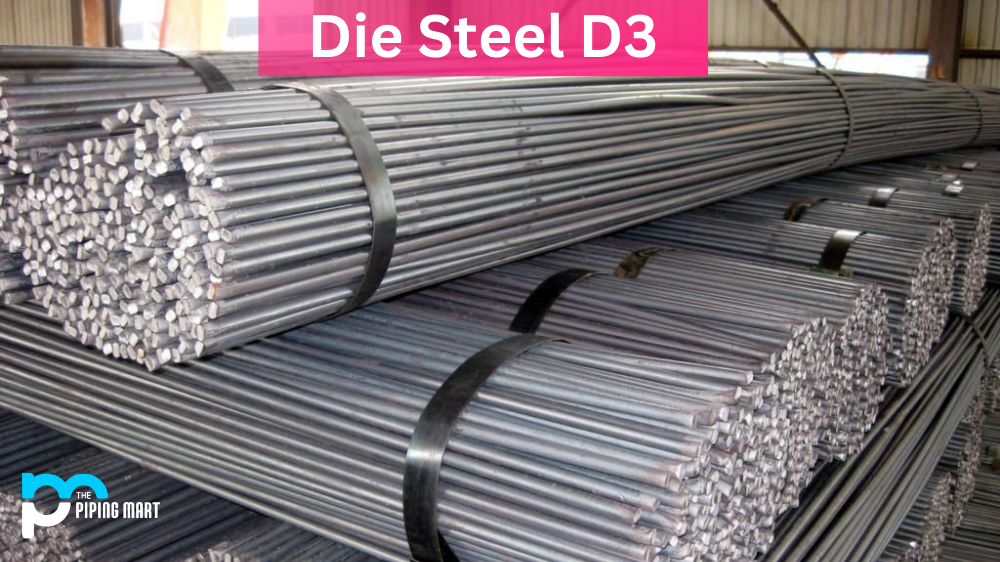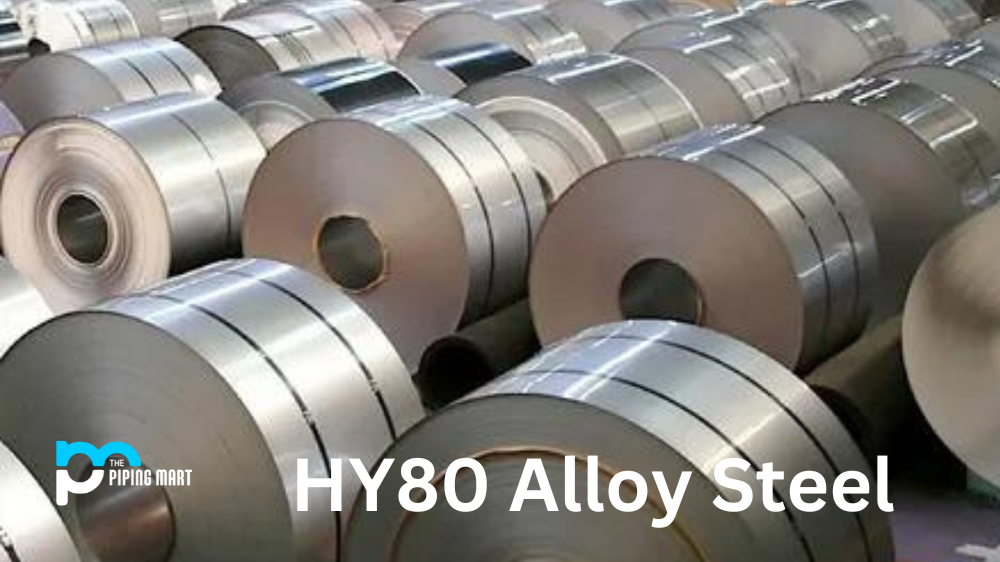Die Steel D3 (SKD1) is a high-carbon, high-chromium alloy tool steel that is commonly used in die casting and forging applications. It offers excellent wear resistance, corrosion resistance, heat resistance, and mechanical properties, making it an ideal choice for many applications. In this blog post, we will discuss why Die Steel D3 is the perfect material for welding and machining tasks.
What Forms is Die Steel D3 Available at Piping Mart?
- Bars
- Bolts
- Pipes
- Screw
- Tubing
- Valves
- Washers
- Flanges
- Fasteners
- Electrodes
Die Steel D3 Composition
Die Steel D3 is composed of 0.50%-0.60% carbon, 12% chromium, 1% manganese, 0.30%-0.50% silicon, 0.0005%-0.0020% sulfur, and 0.70%-0.90% molybdenum. It has a hardness rating of HRC 55-63 and a tensile strength of 785 MPa (114 ksi).
| Element | Content (%) |
|---|---|
| C | 2.00-2.35 |
| Mn | 0.60 |
| Si | 0.60 |
| Cr | 11.00–13.50 |
| Ni | 0.30 |
| W | 1.00 |
| V | 1.00 |
| P | 0.03 |
| S | 0.03 |
| Cu | 0.25 |
Die Steel D3 Chemical Properties
D3 Material has a wealth of chemical properties that make it the go-to choice in many diecasting applications. It is highly resistant to heat and abrasion, making it well-suited for challenging machining tasks such as deep drilling, tapping, threading, and knurling. It has excellent stress-resisting characteristics, and its wear resistance is unparalleled compared to other die steels. Its hardness after heat treatment also makes it an ideal fit for fine surface finishes. All these properties make Die steel D3 the optimal choice when attempting to achieve high-quality components without trading in reliability or strength.
Die Steel D3 Mechanical Properties
Die Steel D3 exhibits excellent toughness and strength, making it a popular choice among steel manufacturers for its usability. For improved hardness at elevated temperatures, D3 is the perfect choice for applications where super-tough strength is required. Its resistance to wearing and high-temperature service make it an optimal choice when high durability is essential. It has superior shock resistance, making it suitable even in extreme production environments. In addition to its exceptional mechanical properties, Die Steel D3 also offers great corrosion resistance, meaning that it can be used in a wide variety of applications without additional coating or treatment.
| Properties | Metric | Imperial |
|---|---|---|
| Izod impact unnotched | 28.0 J | 20.7 ft-lb |
| Poisson’s ratio | 0.27-0.30 | 0.27-0.30 |
| Elastic modulus | 190-210 GPa | 27557-30457 ksi |
Die Steel D3 Physical Properties
Die steel D3 has a number of impressive physical properties that make it a great choice for any die caster. It is able to maintain its integrity in temperatures as low as -40 degrees Celsius, and its refined microstructure allows it to offer superior impact toughness. In addition, Die Steel D3 also offers excellent wear resistance and can be easily machined with minimum distortion. With these parameters taken into account, it becomes clear as to why die steel D3 is a popular choice among those who need an alloy that can handle demanding workloads while still retaining low wear levels and good surface finishes.
| Properties | Metric | Imperial |
|---|---|---|
| Density | 7.7 x 1000 kg/m3 | 0.278 lb/in3 |
| Melting point | 1421°C | 2590°F |
Die Steel D3 Equivalent
Equivalent metals of D3 steel are:
- AFNOR Z 200 C 12
- DIN 1.2080
- UNI X 21O Cr 13 KU
- JIS SKD1
- B.S. BD 3
- ASTM A681
- FED QQ-T-570
- SAE J437
- SAE J438
- UNS T30403
Die Steel D3 Specifications
ASTM A681
QQ-T-570
Die Steel D3 Uses
Due to its unique composition and physical properties, D3 Tool Steel can be used in a wide range of applications, including die casting tools, forging dies, extrusion dies, cold forming tools, punches & dies for plastic injection molding machines & presses; shear knives; hot cutting blades; hammer bits; hydraulic blades; blades for paper cutting machines; drill bits; reamers; thread rolling dies; saw blades; etc. Its excellent wear resistance makes it suitable for use in many industries such as automotive manufacturing & repair shops; aerospace industry; oil & gas industry; construction industry, etc., where parts are exposed to extreme conditions or require higher precision than other materials can offer.
- Die steel D3 is a high carbon, high chromium tool steel that is heat treatable to a hardness of 60 Rc.
- Die steel D3 is used for cold working dies such as punches, blanking dies, and drawing dies.
- Die steel D3 is also used for cutting tools such as milling cutters, reamers, and broaches.
- Die steel D3 can also be used for injection molding dies and diecasting dies.
- Die steel D3 offers excellent wear resistance and toughness, making it an ideal choice for die applications.
- Die steel D3 is available in a variety of sizes and shapes to meet your specific needs.
- Contact us today to learn more about die steel D3 and how it can benefit your application.
Die Steel D3 Corrosion Resistance
Die Steel D3 is an incredibly strong material that is used for many difficult industrial applications. It also offers exceptional corrosion resistance, ensuring that even in the harshest of conditions, it can stand up to extreme weather and chemical exposure without compromising its structural integrity. This makes Die Steel D3 perfect for providing durable parts when long-term protection is necessary. Furthermore, its low cost and versatility make it a suitable choice for almost any application that requires high strength and good corrosion resistance.
Die Steel D3 Heat Resistance
steel D3 is known for its heat-resistant qualities that make it an ideal tooling steel. This strength makes it the perfect choice for applications where high temperatures and heavy wear are expected, such as in the production of injection molds, dies, and punches. Not only does D3 have superior heat resistance making it more durable than normal tool steel, but it also has excellent abrasion resistance as well. While other steels may lose their properties due to the combination of heat and friction present in most manufacturing processes, D3 stands strong because of its ability to resist both heats and wear. There’s no other tooling steel quite like it: die steel D3 is the ultimate combination of heat resistance and abrasion-resistance strength, guaranteeing a better tooling result every time.
Die Steel D3 Machining
The process of die steel D3 machining is a challenging yet rewarding task for those looking for precision and quality results. This type of machining can involve cutting, grinding, drilling, and finishing to produce highly precise parts used in metal stamping operations. As with any machining, the most important step is to use the right tools and techniques to ensure accurate results. Specific drill bits, shears, and taps must be used in order to properly form metal pieces into their desired shapes; lubricants should also be applied as needed to reduce wear and make cutting easier on the tooltips. Working with die steel D3 can be a time-consuming endeavor, but the end product that emerges makes it all worthwhile.
Die Steel D3 Heat Treatment
The optimal heat treatment process for Die Steel D3 depends on the application it will be used in but generally involves heating the material to 815-830°C (1499-1526°F) followed by cooling in air or oil at 50-80°C (122-176°F). This process helps give the material its desired properties, such as improved toughness and better wear resistance, while also increasing its machinability and reducing distortion after welding or hardening operations have been performed on it.
Conclusion
For welding purposes or machining tasks that require superior wear resistance along with excellent corrosion protection against harsh environments like salt water or acids/alkalis chemicals while still offering good mechanical characteristics such as toughness and ductility, then Die Steel D3 should be your go-to choice! No matter what industry you’re working in – automotive manufacturing & repair shops or aerospace – you can count on this alloy steel to provide superior performance when compared to other options available on the market today! With proper heat treatment processes applied after welding operations have been completed, you can ensure that your parts maintain their desired shape without any distortion over time, thus allowing them to last longer under extreme conditions without requiring frequent replacement! Thanks to its extremely high-quality standards combined with exceptional performance capabilities – no wonder why so many businesses prefer using this alloy steel when working with projects demanding precision, even under harsh operating environments!
Sakshee is a talented blogger, with a particular focus on the Business and Metal Industry. She is passionate about sharing her insights on various metal products and helping professionals to make a better decisions.




